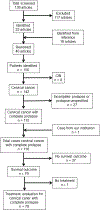Treatment patterns and survival outcomes in patients with cervical cancer complicated by complete uterine prolapse: a systematic review of literature
- PMID: 25971615
- PMCID: PMC7528440
- DOI: 10.1007/s00192-015-2731-8
Treatment patterns and survival outcomes in patients with cervical cancer complicated by complete uterine prolapse: a systematic review of literature
Abstract
Introduction and hypothesis: Cervical cancer complicated by complete uterine prolapse is a rare clinical entity and uniform management recommendations have yet to be determined. The aim of the current review was to examine the effects of management patterns on survival outcomes in cervical cancer patients with complete uterine prolapse.
Methods: A systematic review of the literature was conducted using three public search engines. This included case reports with detailed descriptions of tumor characteristics, cancer management, and survival outcomes. Treatment patterns and tumor characteristics were correlated to survival outcomes.
Results: There were 78 patients with cervical cancer with complete uterine prolapse. Their mean age was 63.7 years. The median duration of prolapse was 147.9 months and 22.2% of the patients experienced persistent/recurrent prolapse after cancer treatment. The mean tumor size was 8.9 cm and squamous cell carcinoma (83.9%) was the most common histologic type. The majority of patients (56.2%) had stage I cancer. Tumor characteristics were similar across the treatment patterns. Survival outcomes were more favorable with surgery-based treatment (48 patients) than with radiation-based treatment (30 patients): 5-year recurrence-free survival rate 72.0% vs. 62.9% (p = 0.057), and 5-year disease-specific overall survival rate 77.0% vs. 68.2% (p = 0.017). After controlling for age and stage, surgery-based therapy remained an independent prognostic factor for better disease-specific overall survival outcome (hazard ratio 0.32, 95% confidence interval 0.11 - 0.94, adjusted p = 0.039).
Conclusions: Although limited in study size, our results at least suggest that surgery-based treatment may have a positive effect on survival outcome in cervical cancer patients with complete uterine prolapse.
Keywords: Cervical cancer; Radiotherapy; Review; Surgery; Survival; Uterine prolapse.
Conflict of interest statement
Figures


Comment in
-
In Reply to the Letter to the Editor on Matsuo et al. "Treatment patterns and survival outcomes in patients with cervical cancer complicated by complete uterine prolapse: a systematic review of literature".Int Urogynecol J. 2016 Aug;27(8):1285-6. doi: 10.1007/s00192-016-3061-1. Int Urogynecol J. 2016. PMID: 27311598 No abstract available.
-
Letter to the Editor regarding: "Treatment patterns and survival outcomes in patients with cervical cancer complicated by complete uterine prolapse: a systematic review of literature".Int Urogynecol J. 2016 Aug;27(8):1283. doi: 10.1007/s00192-016-3062-0. Int Urogynecol J. 2016. PMID: 27311599 No abstract available.
References
-
- Jemal A, Bray F, Center MM, Ferlay J, Ward E, Forman D (2011) Global cancer statistics. CA Cancer J Clin 61:69–90 - PubMed
-
- Maher C, Feiner B, Baessler K, Schmid C (2013) Surgical management of pelvic organ prolapse in women. Cochrane Database Syst Rev 4, CD004014 - PubMed
-
- Richter HE, Varner ER (2007) Pelvic organ prolapse In: Berek JS (ed) Berek and Novak’s gynecology, vol 24 Lippincott Williams and Wilkins, Philadelphia, pp 897–934
-
- Swift S, Woodman P, O’Boyle A, Kahn M, Valley M, Bland D et al. (2005) Pelvic Organ Support Study (POSST): the distribution, clinical definition, and epidemiologic condition of pelvic organ support defects. Am J Obstet Gynecol 192:795–806 - PubMed
Publication types
MeSH terms
Grants and funding
LinkOut - more resources
Full Text Sources
Other Literature Sources
Medical

